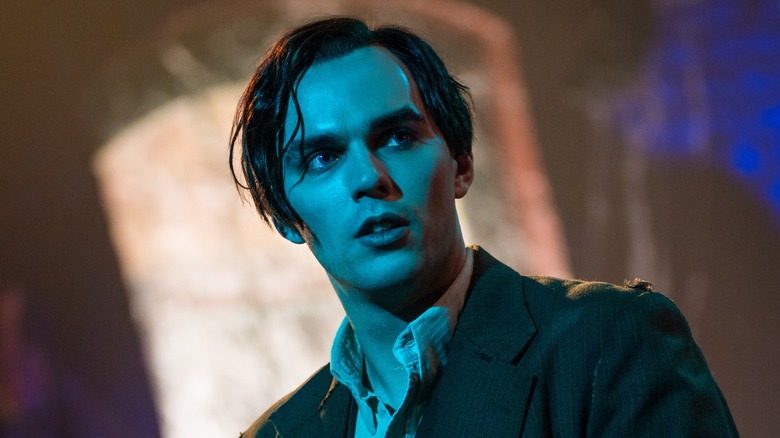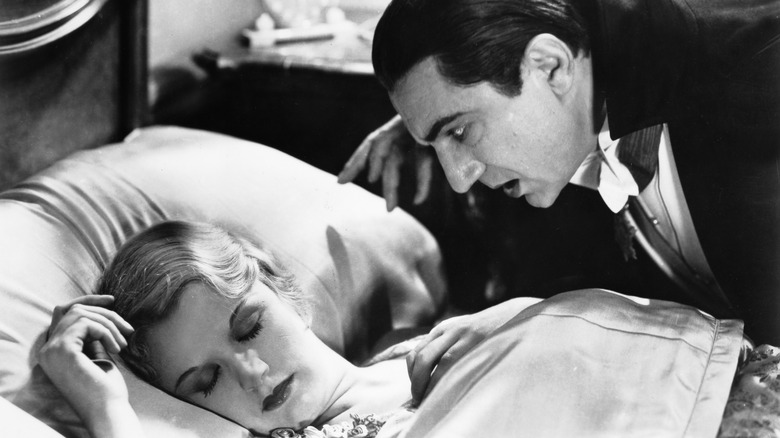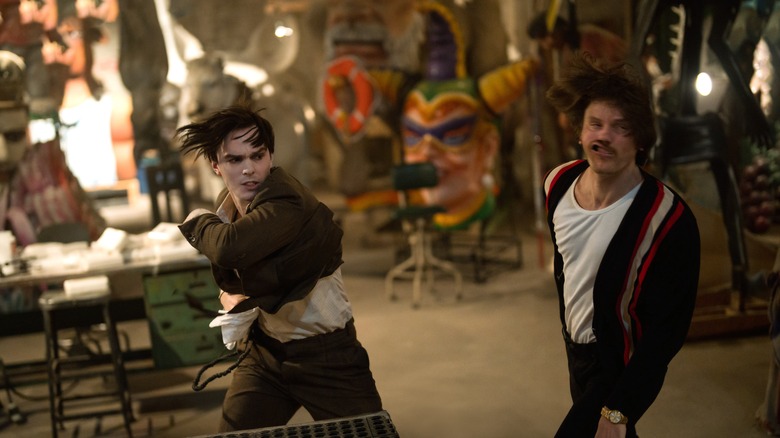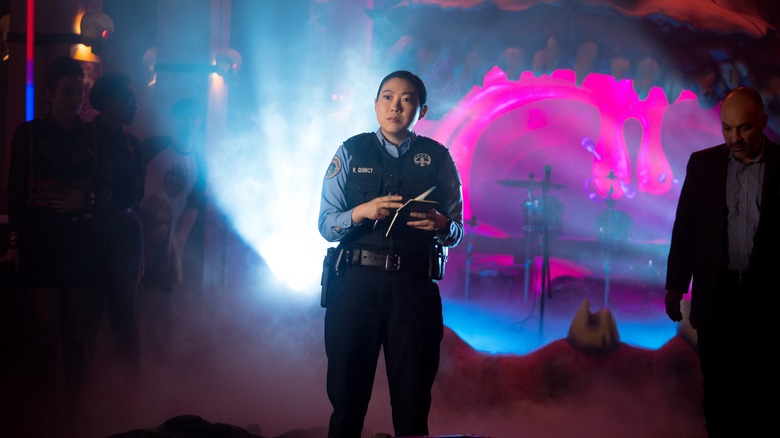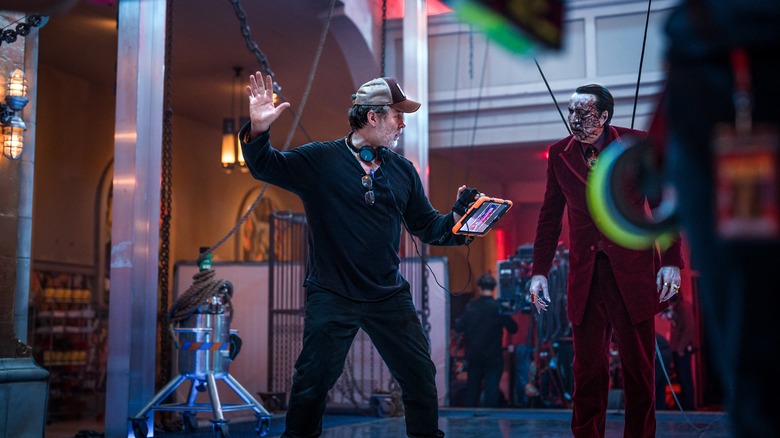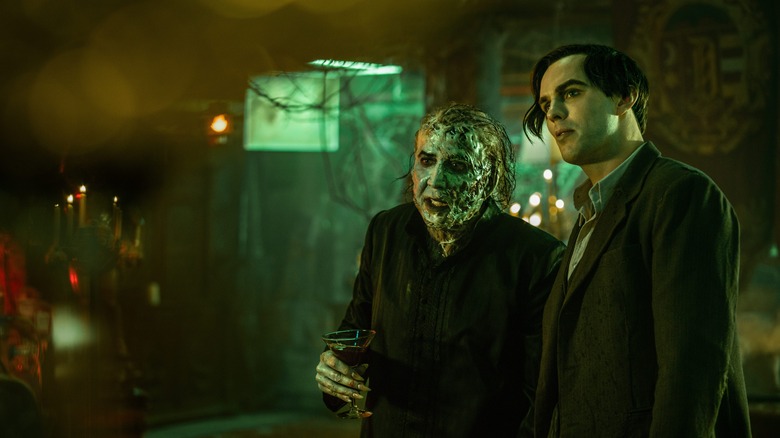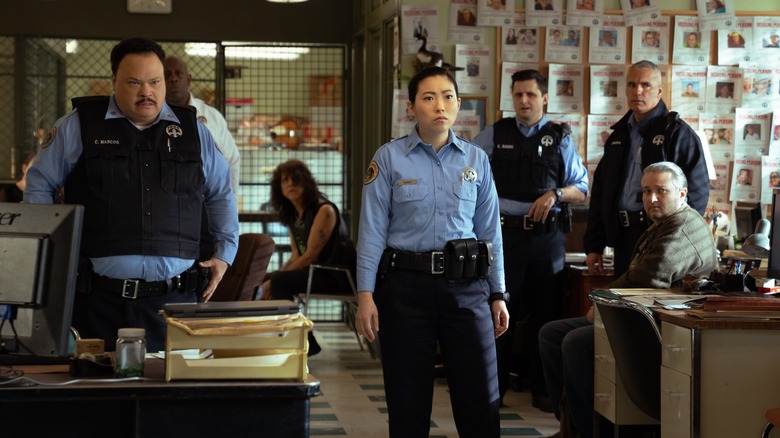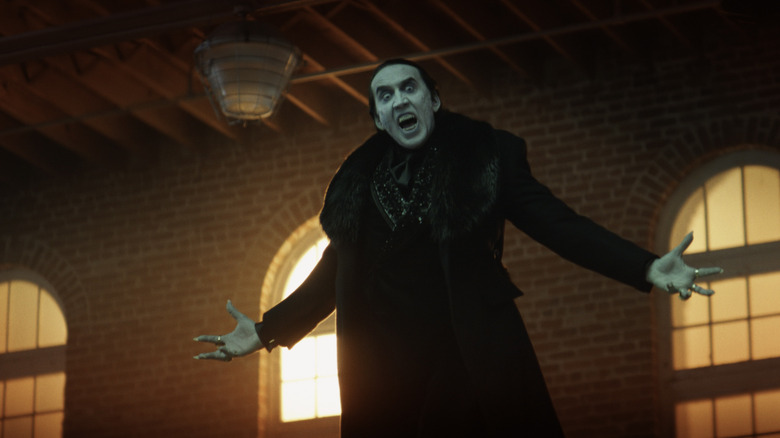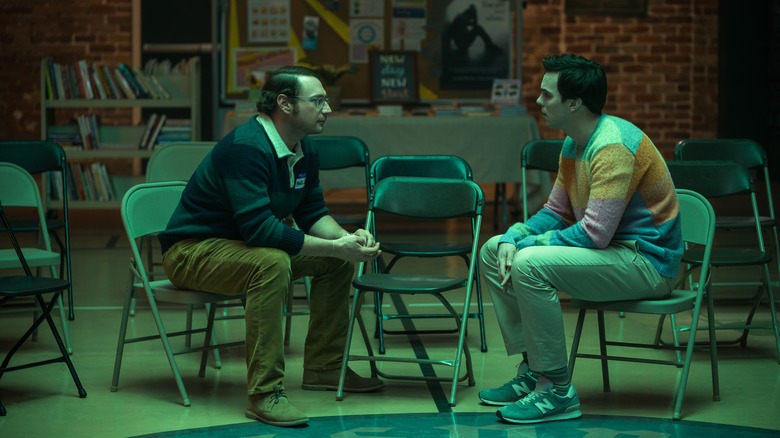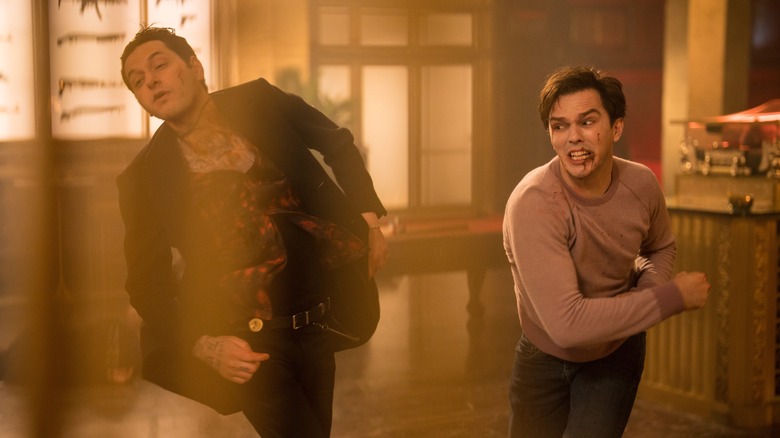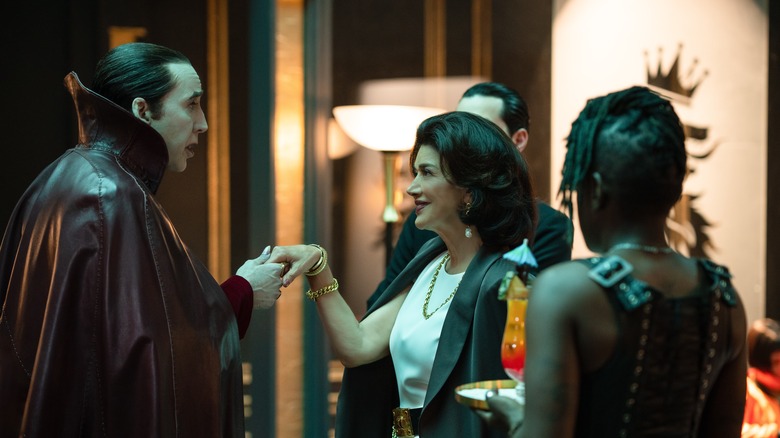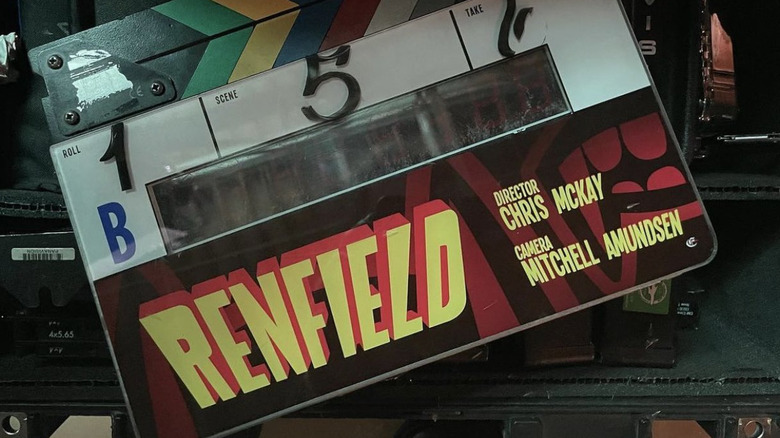Small Details You Missed In Renfield
With "Renfield," "Lego Batman Movie" director Chris McKay tackles an inversion of the century-and-a-quarter-old "Dracula" legend, with help from an idea by Robert Kirkman, and turns it into a vehicle for Nicolas Cage to do that thing he does. Nicholas Hoult stars as Drac's bedraggled assistant, in a comedic examination of the toxic relationship between servant and master. When the vampire and his familiar flee to New Orleans, Renfield finds a support group and begins to see the error of his ways.
Given that "Renfield" lovingly pulls from nearly 100 years of cinematic history, it's no wonder the movie is filled with references, callbacks, and Easter eggs some viewers might overlook. From direct, and not-so-direct, references to the original 1931 Universal Pictures "Dracula" to background gags that you might miss if you blink, "Renfield" takes as many opportunities as it can to pay homage to the horror classics in which it has found inspiration. Each one of these small, spoiler-heavy details in "Renfield" is easy to miss, but adds another layer of complexity to the unique meta-humor of this horror-tinged comedy.
Renfield is technically a sequel to the Bela Lugosi's Dracula
Right from the jump, "Renfield" is fully self-aware of its place in the legacy of "Dracula" — both the character and the history the franchise has at Universal Pictures. What it firmly establishes, in the most tongue-in-cheek way possible, is that this movie is technically a sequel to the original 1931 Universal monster movie starring Bela Lugosi. A backstory-revealing scene in the first five minutes establishes all this by engaging the series history in a playful, meta manner.
The movie takes a sequence from the original "Dracula" and digitally composites Hoult and Cage's faces onto the bodies of the original actors. "Renfield" takes the sequence of the film where Renfield comes to the castle and meets Dracula for the first time and twists it by having Hoult deliver Renfield's lines. Then there is Cage, appearing as the Prince of Darkness in this referential early sequence where he is taking the words (quite literally) right out of Lugosi's mouth.
"Renfield" production designer Alec Hammond alluded to the conceit during a set visit last year. "We're actually using some direct references to the original Universal horror movie," he said. "We definitely use some of those frames. So, even if you'd never seen the 1931 Dracula movie. If you've never seen Bela Lugosi, you will [understand]."
The ska jokes run deeper than it first appears
These days, one of the easiest punchlines is ska — the horn-driven Jamaican music style that began in the late '50s and eventually yielded everything from rocksteady to reggae to bands like The Clash, The Specials, The Mighty Mighty Bosstones and '90s bands like Reel Big Fish and Save Ferris.
"Renfield" leans heavily into its derisive comments about the genre, dedicating an entire running gag to making fun of ska fans. Debatability of the bit's relevancy aside, there is at least a good deal of effort dedicated to the joke as the movie progresses. One case and point is a costuming detail that is easy to miss.
Early on in the movie, there is a scene where a woman in the support group is describing her abusive, drug dealing boyfriend; despite all the terrible things he's done, the worst is that he is a ska fan. The very next scene shows a group of three guys in a warehouse filled with cocaine, and one of them is wearing a shirt that says "NYC Ska." By connecting the dots, viewers can put together that this guy is probably the boyfriend mentioned in that earlier story — or at least, he is one of the three.
Since Renfield is looking for victims who deserve to have their blood sucked, he naturally goes after the ska-loving knuckleheads.
Awkwafina's character name is a reference to Bram Stoker's novel
This little Easter egg might only get picked up by the most hardcore "Dracula" fans in the audience; you have to be familiar with the 1897 Bram Stoker novel (or the 1992 movie adaptation directed by Cage's uncle Francis Ford Coppola, which directly inspired his performance) to connect the character played by Awkwafina to one of the original novel's most important players.
The name of the character played by Awkwafina is Rebecca Quincy. She is a police officer with a true heart and a dark past that gives her reason to unite with Renfield against the Lobo crime family. Ultimately, her friendship helps Renfield see the error of his ways, and together they help each other do good.
Rebecca's last name, Quincy, is most certainly a reference to Stoker's original text. In the "Dracula" novel, there is a character named Quincey Morris. The names aren't the only similarity, as these two characters serve similar narrative functions in their respective tales.
In Bram Stoker's "Dracula" novel, Quincey Morris helps Jonathan Harker defeat the vampire lord. He is a character who went on to appear in multiple adaptations of the tale. This film's Rebecca is a new twist, yet still plays the role in aiding Renfield to overcoming his toxic boss, aka Dracula. By more than just name, Rebecca Quincy is a clear part of the lineage that "Dracula" fans have seen over the years.
The movie was actually filmed in New Orleans
In this time of prevalent CGI, it can be difficult sometimes to tell if movies set in major cities were actually filmed there. But with a city like New Orleans, it is so unique looking that it is hard to fake — if the actor is truly interacting with The Big Easy, you can just tell.
New Orleans has become a popular destination for filmmakers in recent decades as the state of Louisiana has embraced significant tax incentives for production companies, giving films like "Bad Moms," "American Ultra," "12 Years a Slave," both "Jump Street" films, "The Skeleton Key" and Cage's "Bad Lieutenant: Port of Call New Orleans," as well as series like "True Detective" and "Treme" a number of reasons to call New Orleans home. For "Renfield," however, capturing the vibe of the city was just as important as the tax deductions. Using iconic New Orleans locations like Mulates restaurant and Charity hospital for major setpieces infuses "Renfield" with a spirit of New Orleans that you can only get by filming on location.
"This is a city that does have an X factor," Cage said to Nola.com at the film's local premiere. "You don't know how to define it, it's just in the air, it's in the feelings, it's in the mood. You can have a charming time and then in a split-second you could really be a little bit unnerved, and you don't know exactly why."
The hospital Dracula hides out in has a real life dark history
When Renfield first brings the emaciated Dracula to New Orleans, he finds an abandoned building in which to take shelter and build a new lair. Later in the movie, it is shown that Renfield and Dracula are actually staying at the abandoned old Charity Hospital. In real life, the hospital exists and is indeed abandoned. You can find it in downtown New Orleans where, during the day, it sticks out like a sore black thumb. But more than just being a creepy-looking location, Charity Hospital has a dark, potentially haunted history that makes it the perfect locale for vampires to hole up.
The Charity Hospital in New Orleans has been abandoned since it suffered severe damage from Hurricane Katrina in 2005. This history is certainly menacing, but this building's appearance of being haunted makes it even more ideal for its role in "Renfield." Years back, a photo of lights shining from the windows of the hospital went viral. This had some locals and online theorists convinced there were spirits present; while there very well may be, this mystery at least had a rational solution. An investigation led police to discover the source was a pile of 2x4's wrapped in lights, but no further explanations were given. The potential of the supernatural remains very much on the table, however, for those who choose to believe.
There was one big change made to the New Orleans police
While "Renfield" gets most of the nitty gritty of its setting right, there is one New Orleans detail that the movie does not portray with accuracy. It might not be considered a mistake, per se, as it could very well be an intentional creative choice made to add another layer of removal between the real world and the comically gory one in which "Renfield" traffics. This detail concerns the police officers in New Orleans, who play a surprisingly large role in the film.
In addition to centering its B-plot around Rebecca Quincy, the main thrust of the "Renfield"' narrative involves a brewing conflict between the cops and the Lobo mob family. In "Renfield," the police that play such a large role wear badges and uniforms that all say the same thing — P.D.N.O. It even has this abbreviation on the police cars as well, one apparently short for Police Department (of) New Orleans. In reality, that is not what the department is called.
The N.O.P.D. is the official name for the New Orleans Police Department. This is different from the abbreviation employed in "Renfield." Perhaps the city of New Orleans didn't want to see the bulk of its police force portrayed as incompetent. Maybe it had something to do with the gruesome ends so many of them meet. Regardless, this change is only really noticeable to anyone who has spent significant time in New Orleans.
One vampire rule gets a clever twist
The filmmakers behind "Renfield" didn't only draw upon Stoker and his novel's direct adaptations as the source of its vampire touchstones. The notion that vampires must be invited in to enter a domicile has become one familiar vampire cliche, for instance, and like with the rest of its vampire lore, "Renfield" subverts it in a clever way.
In the world of "Renfield," vampires — even ones as powerful as lord Dracula — still need to be invited in to enter a building. This is emphasized when the support group organizer Mark (Brandon Scott Jones) cheerfully invites the dark lord into the meeting near the end of the film. But in a small gag before this moment, "Renfield" subverts the trope.
After Renfield has gone off on his own, Dracula comes looking for his familiar. When he gets to Renfield's apartment, Drac is allowed to come in and wait for Ren to get home, due to the fact that Renfield has a welcome mat outside that literally invites anyone who reads it in. The movie uses this as a clever ploy to get Dracula into Renfield's apartment to have the upper-hand, and is a funny moment in its own right.
Blink and you might miss Renfield's most important motivational poster
As Renfield spends more time with Rebecca and the members of his support group, he begins to create a life and identity outside of his relationship with Dracula. Taking steps to become his own person, Renfield gets his own apartment, which he decorates with a slew of motivational posters.
While many of these posters are fairly generic — often with large, printed words and phrases of inspiration next to pictures of majestic animals — one in particular stands out because of how important it is to the movie. It also receives very little attention.
Blink and you might miss how, on another wall in Renfield's cheery and colorful abode, there is a lone motivational poster that reads "I am enough. I have enough." This phrase is repeated throughout the movie, and is first passed to Renfield in his support group for people in dependent relationships. It can be assumed, perhaps, that this is where he picked up the poster in the first place.
This affirmation ultimately helps Renfield move beyond his codependent relationship with Dracula. When he finally gets the upper hand, he repeats the phrase while beating his (former) master to a bloody pulp.
One kill pays homage to a famed fighting game franchise
While the violence in "Renfield" might polarize some audiences (with its extreme, frequently cartoonish levels of gore that feel more similar to DC's animated "Harley Quinn" show than any previous take on the iconic vampire), in the world of "Renfield," people are depicted as something akin to walking sacks of blood, waiting to be popped like a pimple. Some viewers will love it, others will likely roll their eyes at the excess. But at the very end of the movie, viewers are perhaps more likely to at least understand the inspiration behind the film's outrageous takes on violence and gore.
When Teddy Lobo (Ben Schwartz) is killed by Renfield, there is a moment that echoes the "Mortal Kombat" games. The scene goes full X-ray mode inside Teddy's body, and viewers can see his bones breaking in a sequence of heightened comical violence. This is reminiscent of the X-Ray moves in modern "MK" games that show an enemy's bones cracking in similar style. In fact, this near-direct homage to the fighting franchise is a moment that might make some viewers consider that "Renfield" has done a better job of capturing the "Mortal Kombat" aesthetic than any of the franchise's "official" movies.
Cage's Dracula captures an element of the character most modern adaptations don't
Nicolas Cage's interpretation of Dracula is one for the history books — and in some ways, a perfect book-end to his 1988 freak-out classic "Vampire's Kiss." But for all its zaniness and camp, there is another layer of the character that the actor captures as well.
The charm and allure that Dracula has over women is not lost on Cage. Seduction is a part of such vampire stories that goes all the back to the beginning, and the way Cage and the filmmakers incorporate Dracula's sex appeal is one of the most book-accurate elements of "Renfield."
Near the end of the film, Dracula comes face-to-face with the head of the Lobo mob family, Bellafrancesca Lobo (Shohreh Aghdashloo). In their first confrontation, Bellafrancesca is intoxicated by Dracula's seductive nature; Cage lays on an oddball charm that only he could summon so effortlessly from his acting talents. Dracula uses these powers to his advantage, seducing Bellafrancesca and winning her affections just long enough to let him take over the Lobo clan, turning the henchmen into vampire-worshipping, bug-eating familiars.
The film ends with one final homage to the Universal monster movie classic
Bringing it back around to how the film kicked off, "Renfield" pays direct homage to the 1931 original one last time with its final shot. Before the (appropriately retro-themed) credits begin, there is one final stinger that all longtime "Dracula" fans will recognize, letting them leave the theater with a smile on their faces.
After the action has wrapped up, the movie cuts to a title card. The title "Renfield" appears in the same font synonymous with the 1931 "Dracula." The title logo also pays homage to the colorized posters, featuring a yellow typeface with red highlights.
This striking image is an effective way to bring the tongue-and-cheek love letter to "Dracula" that is "Renfield" to a close. The end credits continue this throwback in a stylish manner that keeps "Renfield" humble by acknowledging the legacy from which is was born.
